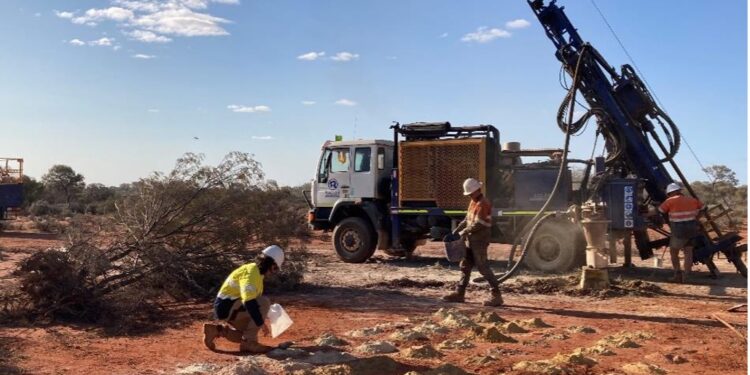Nexus Minerals Limited (ASX: NXM) has commenced regional exploration drilling activities at two prospects MC4.1 and MC3.1, within the company’s Wallbrook gold project, 140km northeast of Kalgoorlie in Western Australia.
“It is great to see the aircore rig turning again exploring the regional targets identified as part of the geophysical assessment,” Managing Director, Andy Tudor, said.
“The assessment programme also included structural, alteration and lithological inputs to allow ranking of targets for drill testing. The first two targets MC4.1 and MC3.1 fit all of the criteria required to host significant gold mineralisation.”
During 2022, Terra Resources were engaged to provide geophysical interpretation on acquired ground magnetic and gravity data collected through the year. Following the geophysical interpretation, several targets were identified for follow up. Nexus has reviewed all exploration data to date in the wider project area, allowing for delineation and ranking of targets that, in addition to the geophysical prospectivity, also highlight structural, alteration and lithological conditions prospective for gold mineralisation.
Aircore drilling has proven to be a successful method of exploration where used previously across the wider tenement package, with obvious success being its use in the 2021 discovery of the company’s Templar Gold Prospect. Considering this, two targets suitable for aircore drilling and prospective for gold mineralisation are being tested, Target 4.1 and Target 3.1.
Several exploration techniques have been used in refining the aircore targets: initially ground magnetics, gravity data and historic geochemical data, followed by geological mapping and ground truthing.
In association with the Nexus exploration team, Terra Resources has produced a high quality detailed geological map of the Wallbrook tenement package, using the regional geophysical datasets to highlight various structural features.
Following Nexus geologists increased understanding of the controls on mineralisation at the company’s Crusader-Templar Prospect, gold mineralisation occurs proximal to northeast-southwest trending faults and mafic dykes. This is indicative of a structurally complex setting that provides conduits for mineralising fluids. In addition to this, magnetic data can be used to highlight corridors of potential hydrothermal activity while the gravity data highlights corridors that may have been subject to felsic intrusive activity. Historical geochemical data with elevated gold anomalism is present across Targets MC4.1 and MC3.1
Solomon Prospect Results
The final results from the Solomon prospect drilling have now been received. The drilling successfully intersected the mineralisation on all four lines, associated with sheared and hematite altered mineralised quartz porphyry units, “the right rocks”, hence defining the mineralised corridor. This will aid Nexus in guiding follow up RC drill programmes to ultimately test the full 5km strike length of the mineralised corridor. There will be a natural “pinch and swell” morphology to the mineralisation and closer spaced drill lines (<100m spacing) will be required to determine where the best of the mineralisation lies, along the 5km of strike extent identified by Nexus to date.
Best results from Solomon Prospect drilling include:
o Hole #449: 10m @ 3.40g/t Au (within 22m @ 1.88g/t Au from 133m);
o Hole #451: 3m @ 4.69g/t Au (within 26m @ 1.06g/t Au from 258m).
Clement Prospect Results
The final results from the Clement Prospect drilling have now been received. The prospect is located 500m to the east of the Crusader-Templar prospect, in an adjacent mineralised corridor MC2. Encouragingly sheared and altered hematite altered mineralised quartz porphyry units were intersected being “the right rocks”.
Best results include:
o Hole #465:4m @ 3.73 g/t Au (within10m @ 1.70 g/t Au from 151m);
o Hole #461:2m @ 5.57 g/t Au (within 10m @ 1.29g/t Au from 71m).
For further information please visit: https://www.nexus-minerals.com/












